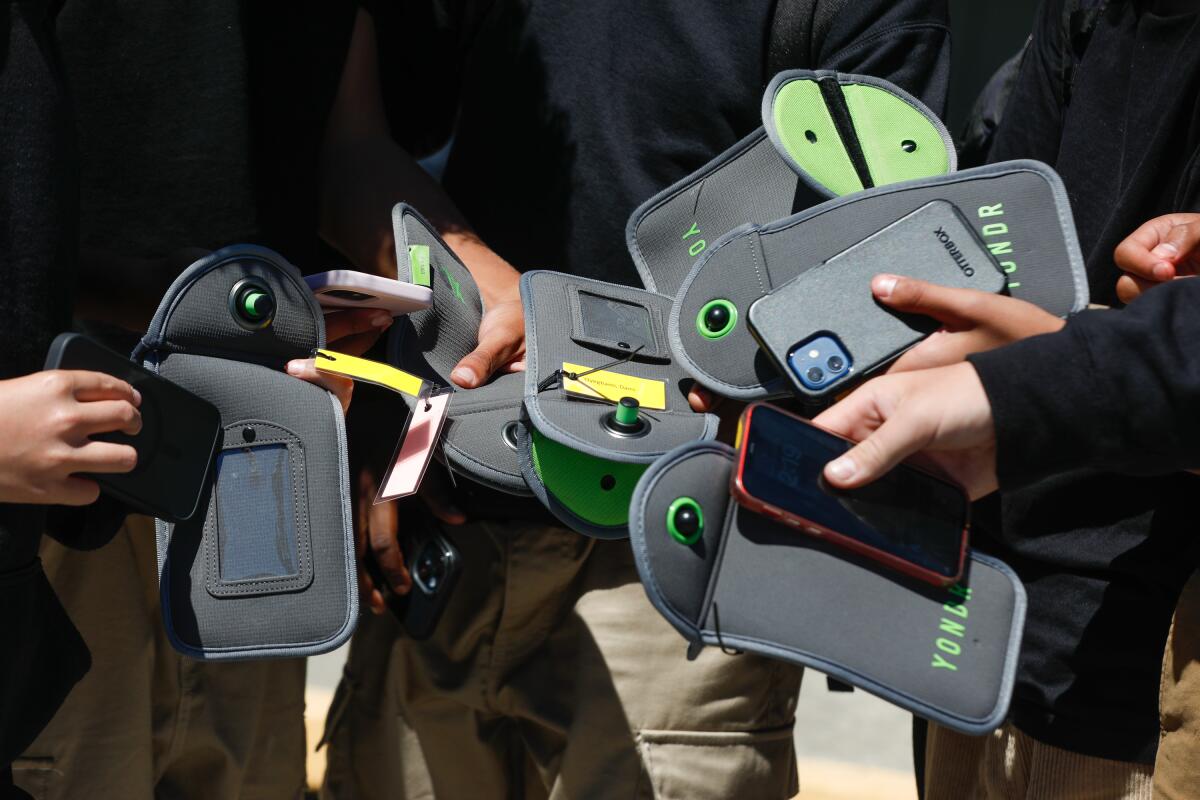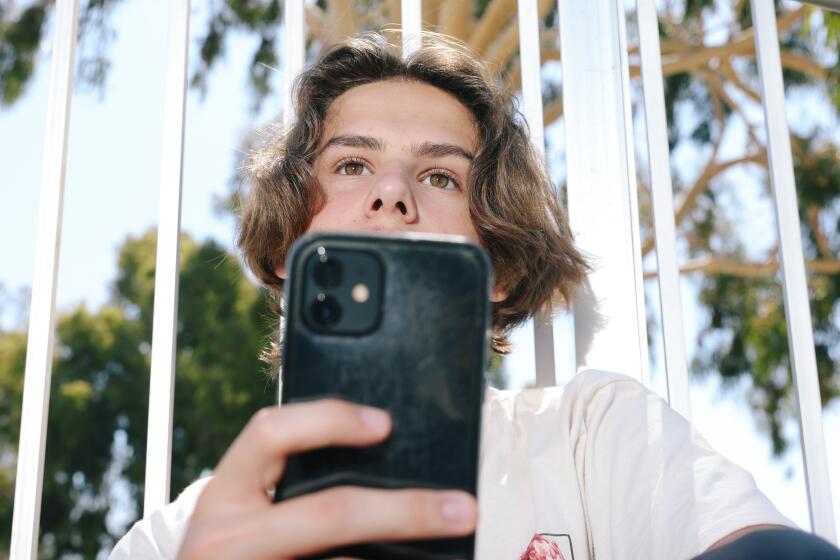California orders schools to restrict cellphone use amid student distractions, anxiety

- Share via
Gov. Gavin Newsom on Monday signed a bill into law that will require California school districts to restrict or ban student cellphone use, thrusting the state with the largest K-12 population in the nation into the forefront of a growing movement to get distracted students off their devices in the classroom and focused on learning.
The law, called the Phone-Free Schools Act, requires California’s 1,000 school districts, charter schools and county education offices to draft student cellphone policies by July 1, 2026. It leaves it up to local schools whether students should be banned from using cellphones altogether. But the law requires schools to restrict phone use in order to “support pupil learning and well-being.”
“We know that excessive smartphone use increases anxiety, depression, and other mental health issues — but we have the power to intervene,” Newsom said in a statement after signing the bill. “This new law will help students focus on academics, social development and the world in front of them, not their screens, when they’re in school.”
The law comes after the Los Angeles Unified School District approved an even stricter policy than the state, calling for an outright phone ban during the school day by January 2025. Details of how the ban will work are under discussion.
California joins several states in a quickly expanding effort to restrict or ban students from using cellphones while on campus.
Last year, Florida passed a rule barring student cellphones from K-12 classrooms. A similar law goes into effect next year in Indiana, while in Ohio the governor recently signed a bill into law that makes schools come up with policies to “minimize” student cellphone use. In Virginia, the governor has also ordered schools to have “cellphone-free education” by January by requiring students to store their phones during the day, including lunch.
Here’s are the details of California’s Phone-Free Schools Act, approved by lawmakers and sent to Gov. Gavin Newsom. Get ready for a massive change for cellphone-obsessed students.
In New York City, officials with the nation’s largest school system said last month that they would table plans to reintroduce a cellphone ban, which had been in effect until 2015. New York Mayor Eric Adams said he and the school chancellor wanted to see how restrictions worked in Los Angeles and elsewhere before moving forward.
While intentionally flexible, California’s law contains a few specifics. It says schools cannot ban a pupil from having a cellphone when a licensed physician or surgeon says that the student needs the device for health-related reasons. It also says students in certain individualized education programs may be allowed to bypass the restrictions.
Under the legislation, students will be allowed to access to phones during emergencies. The law, however, does not say that a phone must be a student’s own device. It’s up to school districts to decide what constitutes an emergency and how phones can be used.
The issue of emergencies has been a point of opposition from students and parents. Last month, after students texted parents during a shooting at a Georgia high school that killed four people, Newsom answered questions at a news conference about his support of cellphone restrictions.
“All kinds of considerations” will be made as schools spend the next two years designing policies, he said, adding that cellphones are “disrupting the ability to get quality academic time.”
L.A. Unified Supt. Alberto Carvalho said the district is working out when student can use phones in class, what scenarios will be defined as emergencies and how schools can provide students with “reasonable access” to phones in those circumstances.
On other exceptions, he said, students who are English learners may need to rely on their devices to learn, just as students with diabetes may require a phone to monitor their glucose levels.
The state law also gives teachers and administrators permission to override their school district’s policy, effectively creating their own.
L.A. Unified still has key decisions to make with its rules, including how much autonomy to give schools to make their own cellphone policies. Options under consideration in L.A. include using cellphone pouches that remained locked until a student opens them using a magnetic device. Phones also could be collected at the start of a class or placed in cellphone lockers. Technology also could be deployed to make cellphones unusable for phoning, texting and internet access even if the devices remains in a student‘s possession.
“We are glad to see the rest of the state may follow our lead to support student learning and mental health,” said Los Angeles school board member Nick Melvoin, who authored the L.A. resolution.
A spokesperson for the district added that LAUSD hopes the state law “fosters a drastic change in a generation of students who will be able to focus on learning, engage in social interactions and revel in the learning environment without the distractions and peril of cellphones.”
In Los Angeles, teachers and parents have been largely supportive of restrictions. In addition to emergencies, some parents have expressed concerns coordinating schedules, such as school pickups. Students have been notably less enthusiastic, although some have been won over at schools that already have adopted cellphone restrictions.
Upon hearing of the new state law, Madison Thacker, a senior at Van Nuys High School, said she hoped school districts would avoid total cellphone bans and only enact restrictions.
“There is a big difference between cellphone using in class time as opposed to during lunch and nutrition or other activities,” said Thacker, who said the Los Angeles ban is “all students are talking about” at her school, where she is in a performing arts magnet program.
“Yes, I see why we need limitation in class time, but cellphones are part of our lives.” she said. “I don’t see why we they need to be taken away when we are not in class. I don’t see why we need a total ban or to treat cellphones like the enemy.”
Students, whose cellphones are an extension of their very being, mull pending L.A. school ban of the devices with praise and frustration.
A handful of L.A. public schools already had cellphone bans in place before the districtwide action. Leaders at those schools say the results have generally been positive — although some teachers said enforcement can be difficult and students find ways around the rules, including bringing two phones to school.
Introduced by Assemblyman Josh Hoover (R-Folsom), the bill easily passed through both legislative chambers with Republican and Democratic support. In a letter last month addressed to state schools, Newsom urged “every school district to act now to restrict smartphone use on campus.”
At least one major group, the California School Boards Assn., opposed Newsom’s stance on the law.
Spokesperson Troy Flint said the measure takes authority away from school district leaders who may do their own research and decide that limiting or banning phones would not benefit their students
Despite this position, Flint said his association would support school districts in their efforts to follow the new law and monitor its impact and possible unintended consequences.
Times staff writer Mackenzie Mays contributed to this report.
More to Read
Sign up for Essential California
The most important California stories and recommendations in your inbox every morning.
You may occasionally receive promotional content from the Los Angeles Times.














